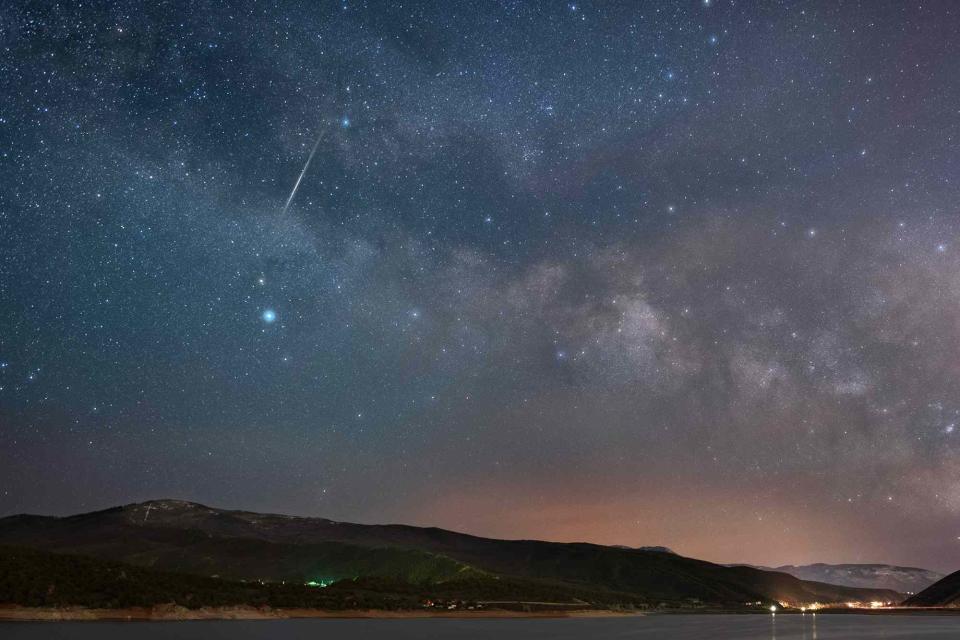From a Meteor Shower Peak to Planet Sightings, Here are the Best Night Sky Sights for May
A strong meteor shower will continue spring’s astronomical sightseeing.

Nam Do/GETTY IMAGES
Last month’s total solar eclipse proved why 2024 is one of the biggest years yet for astrotourism, and the night-sky fun is far from over. This May alone will see a flurry of activity, from a strong meteor shower under near-perfect moon conditions to multiple moon-and-planet meetups. For those in the northern hemisphere, May stargazing comes with another treat: warmer weather.
If stargazing is on your agenda for this month, here are the top night-sky attraction to watch.
May 4-5: Eta Aquarid Meteor Shower Peaks
The stars have aligned for 2024’s Eta Aquarid meteor shower. With a nearly new moon, stargazers have increased odds of catching shooting stars. The Eta Aquarid meteor shower is caused by space debris from fan-favorite space rock Halley’s Comet, according to Space.com.
The shower is most visible in the southern hemisphere, but northern hemisphere stargazers can catch the show, too. At its peak, the shower could produce up to 50 meteors per hour, although northern hemisphere stargazers are expected to see closer to 10 to 30. Look to the Aquarius constellation from around 2 a.m. local time until dawn to catch it. For the best viewing, watch from a dark-sky destination.
May 4-5: See the Moon, Mars, and Saturn — and Maybe Neptune
Just before sunrise on May 4 and 5, the thin crescent moon, Mars, Neptune, and Saturn will gather just above the eastern horizon. Look for the moon between Mars and Saturn around dawn on May 4, and the moon just left of Mars on May 5, according to the Farmers’ Almanac. While Neptune will be hanging around, you can only see it with strong stargazing binoculars or, better yet, a telescope. You’ll need an unobstructed view to the eastern horizon — think: a large lake or hilltop above the trees — to see them.
May 7-8: New Moon
The new moon, when the space rock is at its darkest, is the best time to go stargazing. This month, the new moon hits overnight from May 7-8. To take advantage of it, watch for the Milky Way rising low along the north to southeast horizon around midnight, with the vivid core toward the latter. The Milky Way will rise higher as the night goes on. The night’s moon is also considered a “new supermoon.”
Most stargazers are familiar with this term for a full moon — when the orb appears larger than normal — but it also occurs during a new moon. We just can’t see it. This month’s will be the last new supermoon of the year, according to Farmers’ Almanac. The first full one will adorn our evening skies in August.
May 9: Mercury Reaches Greatest Elongation
If you’ve been wanting to spy on Mercury, May 9 is your chance. On this day, Mercury will reach its greatest distance from the sun, also known as its greatest elongation. It will be 26 degrees away from the sun, making May 9 one of the best times of the year to spot it. Head out in the pre-dawn hours and look toward sunrise in the east to see the small planet, which will appear near Mars and Saturn, according to EarthSky. It can be seen with the naked eye, although stargazing binoculars and a telescope will enhance your viewing.
May 23: Full Flower Moon
April showers bring May flowers—and, this month, the May full flower moon. It reaches its fullest state on May 23 at 9:53 a.m. EDT, but will be most visible on the nights of May 22 and 23. It earned its nickname for the abundance of blossoms the month brings; the name comes from the Algonquin peoples, according to The Old Farmer’s Almanac.
May 31: Moon and Saturn Conjunction
If you missed the moon and Saturn hang-out in the early May night sky, bookmark May 31 for another shot. According to the Farmers’ Almanac, the moon will glide within almost one degree of Saturn. Like all planets, Saturn won’t twinkle. Instead, look for its steady yellowish glow. Point your eyes to the eastern sky between around 2 to 4 a.m. EDT to see the pair, according to stargazing app Star Walk.
For more Travel & Leisure news, make sure to sign up for our newsletter!
Read the original article on Travel & Leisure.


